For the 3 Cards, 3 Continents Challenge, I’ve been busy finding and pricing various ANA Round the World awards. As a result, I’ve learned some new things since originally publishing this post. The post below has been updated with info about putting awards on hold, which changes are allowed after booking, how and when to call ANA, and updates to which carriers impose fuel surcharges….
One of the best deals in travel is ANA’s Star Alliance Round the World award. We previously covered this award here: Around the world in business class for 115K [Sweet spot spotlight]. More recently, I wrote about my initial planning for an expected-to-be-awesome Round the World trip (that trip never happened due to COVID). In response to our previous posts, many readers offered up useful tips. And, in researching booking these awards, I’ve developed some tips of my own. Below you’ll find a summary of tips for successfully booking ANA’s Round the World awards.

ANA’s Round the World Pricing and Rules
Before getting to our tips, here are the basic rules for booking these awards as found on ANA’s website:
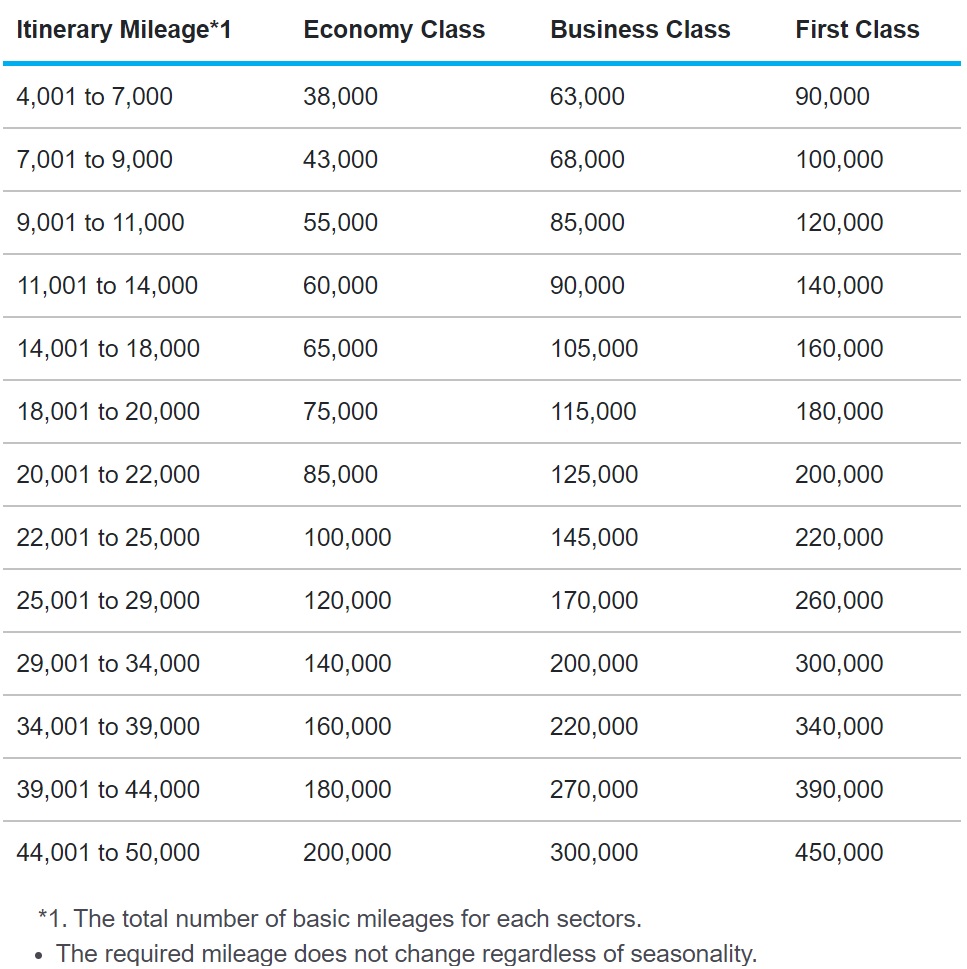
- Required mileage is calculated according to the total basic sector mileage for the entire itinerary. (Calculations exclude ground transportation sectors.). In other words, add up the distances of every segment flown. Do not count open-jaw distances. For example, if you take alternative transportation, such as a train, to get from one city to another, that distance is not included in the calculations.
- Mixed classes: The required mileage for the highest class of travel in the entire itinerary will apply. In other words, if you fly some segments in business class and some in economy, the entire trip is priced based on business class pricing.
- You must fly in one direction (either east to west or west to east). Backtracking is not allowed.
- You must cross both the Atlantic and Pacific oceans.
- You can have a max of 12 segments and a max of 4 “ground transfer” segments (like “open jaws” — for example, fly to Copenhagen and then take a train to Madrid to catch your next flight instead of flying).
- A maximum of 8 stopovers are allowed. A stopover can be:
- A city where you fly and stop to spend a few days
- Either end of an open jaw. For example, if you fly into Copenhagen and take the train to Madrid to catch your next flight, both Copenhagen and Madrid count as stopovers. However, you do not count the distance from Copenhagen to Madrid when determining the price of your ticket
- No more than 3 stopovers in Europe
- No more than 4 stopovers in Japan
- Your trip must last at least 10 days from the departure of your first international flight.
- Flights may be operated by ANA or Star Alliance partners
- Your itinerary must touch at least one country in each of the three following “areas”:
- Area 1: North America, South America, Central America, Hawaii
- Area 2: Europe, Middle East, Africa
- Area 3: Japan, South Korea, China, Southeast Asia, South Asia, Southwest Pacific
- You have one year from the date of your first flight to complete your Round the World trip.
Some backtracking is possible
While the rules are clear that backtracking is not allowed, a reader named Bill reported that agents may have some leeway to allow it within a region. For example, Bill was flying from Vienna to Bangkok and got the impression that they would have allowed him to book it as Vienna to Zurich to Bangkok — which technically backtracks westward from Vienna to Zurich before going east to Bangkok.
A reader named Will backed this up with additional observations:
Their backtracking rule seems to be applied by the agents, and it’s very broad. It’s basically that you can’t cross from one of the IATA-defined “Areas” like Europe, then into Asia, and then back to Europe. Other than that, you have a lot of flexibility. I believe IATA calls them TC1, TC2, TC3.
And this is from a reader known as AS:
You can definitely deviate and backtrack if you need to. I talked to a rep and he explained it this way. If you’re going from the US to Australia, then that’s hard to find award space so you will probably need to go to Asia first and then route to Australia from there. The rep told me they know this and don’t have a problem with it. I think the spirit of the rule is they don’t want you zig-zagging all over the place, but within zones there is flexibility. I traveled SIN-PER and I was traveling west, so I definitely backtracked.
Up to 72 hour hold is allowed, depending..
In a previous version of this post, I wrote that holds were not allowed, but I was wrong. I’ve put two different trips on hold in the past several weeks. For the first one I was told that it could be held up to 24 hours. For the second one, I was given 72 hours. Apparently, the timing is dependent upon the airlines in your booking. I was told that some specific carriers don’t allow holds or only allow shorter holds and so your mileage may vary.
Here is what I wrote when this post was first published:
Despite a reader named Bill telling us that you can place the award on hold for 3 days, I and other readers have been told that no holds are allowed. This is really unfortunate because transfers from Amex Membership Rewards to ANA often take a couple of days to complete. By then, the award space you found could be gone.
I suspect that in my previous failed attempt to put a RTW trip on hold I may have included an airline that doesn’t allow holds.
Some changes allowed for free
According to agents I’ve spoken with, there are three changes that can be made for free:
- Change the flight time (but keep exact same carrier and route)
- Change the flight date (but keep exact same carrier and route)
- Change the class of service upward to the one you paid for (for example, if you booked a business class Round the World trip, you can change an economy segment to business class once a business class seat opens up). You may have to pay additional taxes and fees when doing this.
These free changes make it possible to book something now that is close enough to what you want and to later change it to what you really want. There are many flights where business class awards reliably open up only near departure. If your heart is set on a particular flight, this can be a great way to make it part of your trip. Obviously, though, it is risky because the award space you want may never appear.
1 Year Limit: Note that there is a limit to how far into the future you can move your flights. I was told that the Round the World ticket is valid for 1 year from the date of your first flight.
96 hour rule: I don’t know if this rule is strictly applied, but at least one agent told me that changes must be made more than 96 hours in advance of your scheduled flight.
Award availability may not match expectations
Multiple readers offered up this advice. If you find award space via one tool (for example, I often use United.com to find Star Alliance award availability), ANA might not be able to find the same award space. This is most likely due to something known as “married segment logic”. This is where award space may be available from point A to C with a layover in point B, but it might not be available if you look for award space individually from point A to B or B to C.
Here’s an example: when searching for award space to Africa, I found an award from Newark to Addis Ababa (Ethiopia) with a layover in Lisbon in-between. It’s possible (or even likely), that if I looked for award space only from Newark to Lisbon that it wouldn’t be available. The work around, then, is to make sure to tell the ANA agent that you want to travel from Newark to Addis Ababa rather than Newark to Lisbon. Hopefully, then, they’ll be able to find the route you want.
Reader L M points out that it’s very helpful to have alternate options ready to go when speaking with an ANA agent:
Still had phantom inventory display, so it really helped to have back up dates/flight options to propose to the ANA rep. when booking the itinerary. They’ll also be able to check inventory for options in that case, but the process is much smoother for coming in with your own alternatives.
ANA offers better award space to elite members
If you want to fly ANA itself, you’ll have better access to awards by booking with ANA miles than by booking with miles from an ANA partner. And, if you have elite status with ANA, you’ll find even better award availability. This applies only to flights flown by ANA.
Go west to reduce jet lag

Multiple readers suggested that it was better to fly westward around the world rather than east. Presumably this is because people believe that there’s less jet lag when flying west (and there seems to be some scientific evidence for this). There’s a downside to this, though: eastbound flights are faster…
Go east to reduce time in air
If you prefer to minimize flying time rather than jetlag, then it makes the most sense to go east. Eastbound flights take advantage of the jet stream whereas westbound flights fight against it.
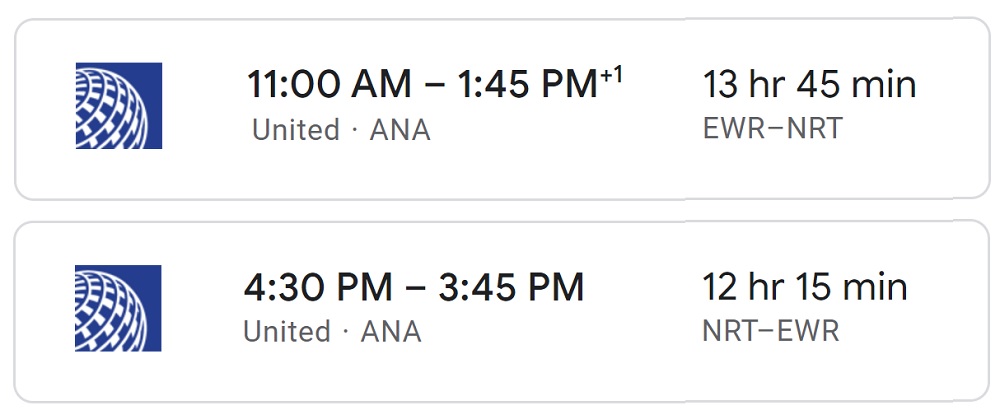
United’s non-stop route between Tokyo (ANA) and Newark (EWR) is a good example. Above, you can see that the westbound flight is scheduled for 13 hours 45 minutes whereas the eastbound flight is scheduled for only 12 hours 15 minutes. If all else was equal, you would cut an hour and a half off your in-flight schedule by flying this route eastward.
Start or end in Hawaii
Multiple readers have suggested starting in Hawaii and ending on the east coast U.S. (or starting on the east coast and ending in Hawaii) as a way to greatly reduce the total flight distance calculated into the award cost. One could then use Turkish miles (transferred from Citi ThankYou Rewards) to fly between Hawaii and the US mainland very cheaply.
I’ve confirmed directly with ANA that this trick does work. In other words, it’s possible to start your Round the World trip on the east coast of North America (e.g. from Boston, Quebec, New York, etc.) and end the trip in Hawaii in. This will reduce the total number of miles flown and so may mean far fewer ANA miles required to book it.
Use the Star Alliance Round the World Tool
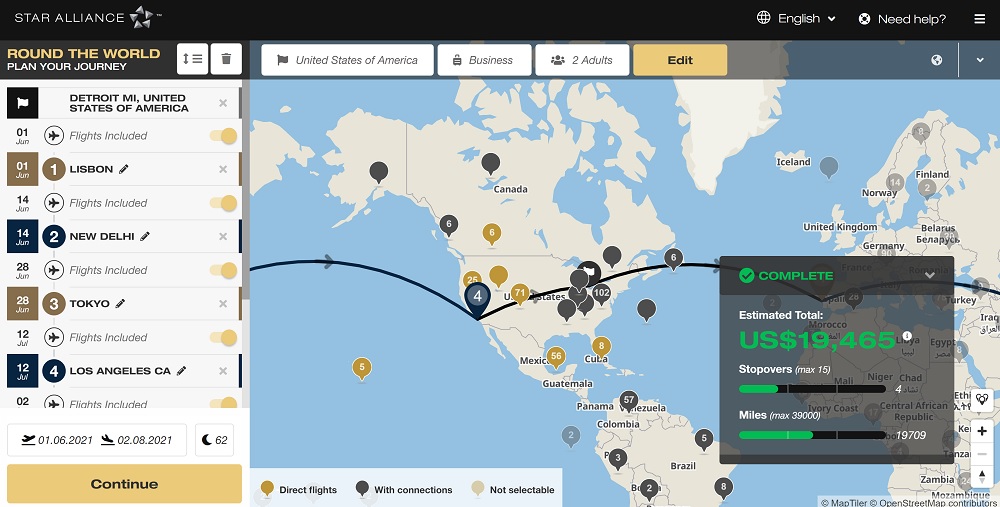
Star Alliance offers a Round the World planner (found here). It is intended for piecing together a paid Round the World trip, but it is also useful for finding flight options and identifying fees (taxes, fuel surcharges, etc.) that would be imposed on an award.
Hat Tip: AS
Don’t count on Great Circle Mapper distance calculations
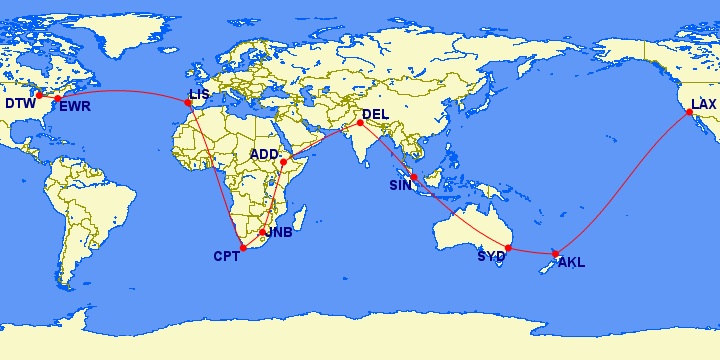
Great Circle Mapper is a terrific tool for visualizing trips and calculating flight distances. Unfortunately, the distances reported by this tool (and every other tool I’ve tried) do not match the distances that ANA uses. In my experience, ANA usually uses slightly lower numbers, but not always.
That said, Great Circle Mapper is a great tool for getting the ballpark distance measurements.
Call at 9am Eastern
Unfortunately, Round the World Awards can’t be booked online. You have to call. And, unfortunately, you’ll often encounter very very long hold times. I’ve had the best success by calling at 9am ET.
ANA’s website lists this U.S. number for Mileage Club related calls:
1-800-235-9262
If you have Platinum status with ANA (thanks to the status match, perhaps), call this number instead:
1-888-633-2262
When I’ve tried calling the Platinum desk mid-day or in the evening, I’ve been on hold forever. When calling at 9 in the morning eastern time and during a weekday, I’ve gotten through within 10 or 15 minutes.
Previously, Oldporkchops suggested calling into a smaller ANA call center:
If the line is dropped or if you need to call back for whatever reason, you have a higher chance of speaking with the person you spoke to, or the person who you believe has the best service attitude… I was looking through my phone’s contact list and found numbers for ANA Hong Kong (+852 2810 7100) and Singapore (+65 6323 4333).
I tried Oldporkchops suggested numbers (timed so that it would be morning in those countries), but without success. I also tried calling the Japanese call center at what would be 8am or 9am their time. No luck.
Fly airlines with low (or no) fuel surcharges
This one comes from Nick’s original post about ANA’s Round the World award. Even though the mileage price for these awards is extremely low compared to alternatives, the cash component can be extreme if you fly segments on airlines that charge outlandish fuel surcharges.
Star Alliance airlines with no or low fuel surcharges (on most routes)
- Aegean Airlines
- Air Canada
- Air China
- Air New Zealand
- Avianca
- Copa Airlines
- EVA Air
- Scandinavian Airlines (SAS) [see this post for details]
- TAP Air Portugal
- United Airlines (most routes)
Star Alliance airlines with medium fuel surcharges (on most routes)
- ANA
- Asiana
- Ethiopian
- LOT Polish
- Singapore Airlines
- Turkish (higher than the others but low by comparison to some)
- United Airlines (certain routes)
Avoid these airlines with notoriously high fuel surcharges
- Austrian
- Lufthansa
- Swiss Air
Use United.com to find awards
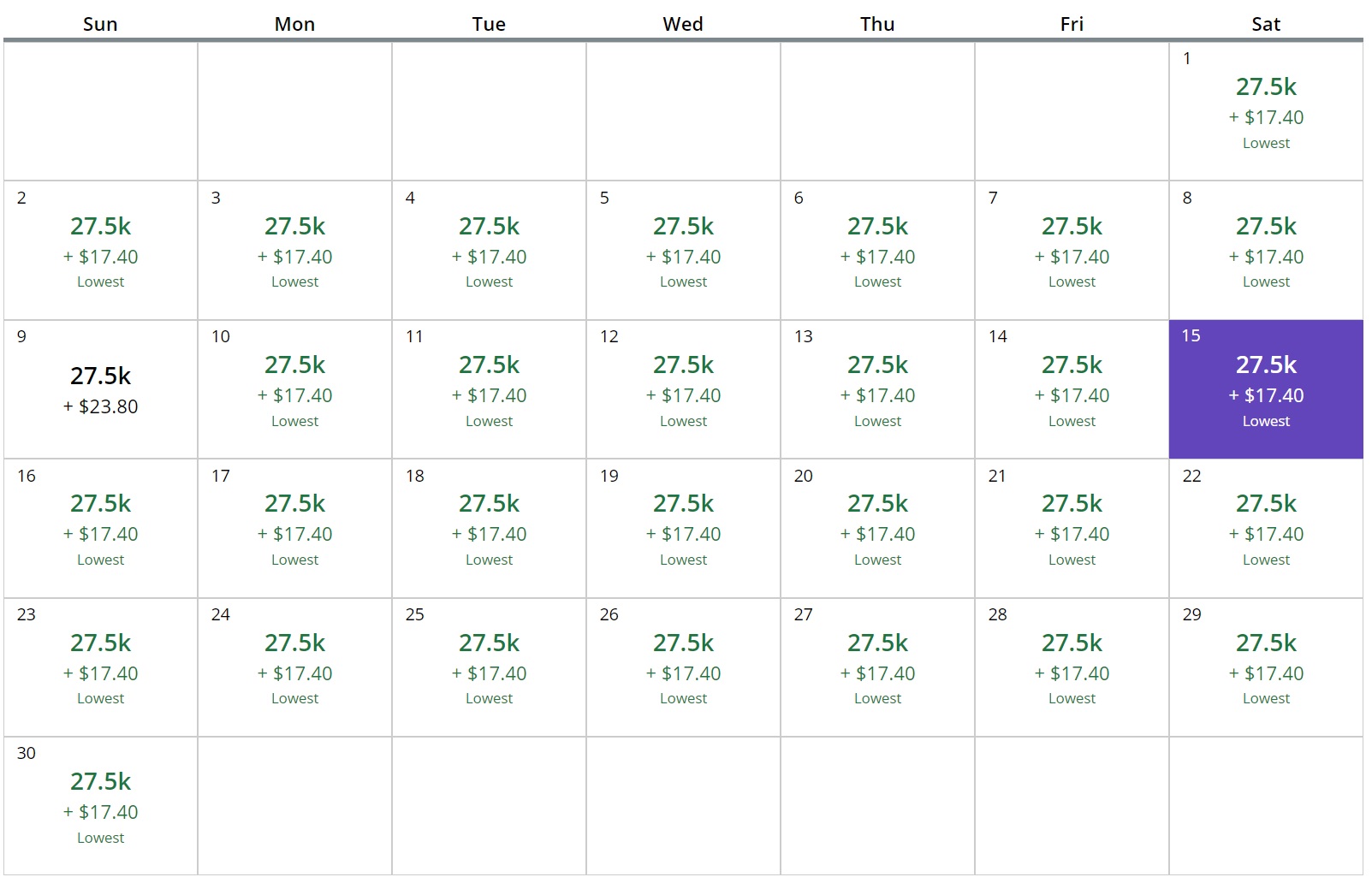
Unlike ANA’s website, United’s website makes it easy to search for Star Alliance awards and to view results a month at a time. I always start my searches there.
It’s important, though, to note several limitations:
- United will show results for United’s own flights which are not available to book via ANA.
- United won’t show some ANA award space that is available only to ANA’s own members.
- United will show award space for its partners that are not Star Alliance carriers (Hawaiian Airlines, for example). ANA will not be able to book these flights.
- The award pricing and taxes and fees shown on United are meaningless when booking through ANA.
Tips for using ANA’s award search
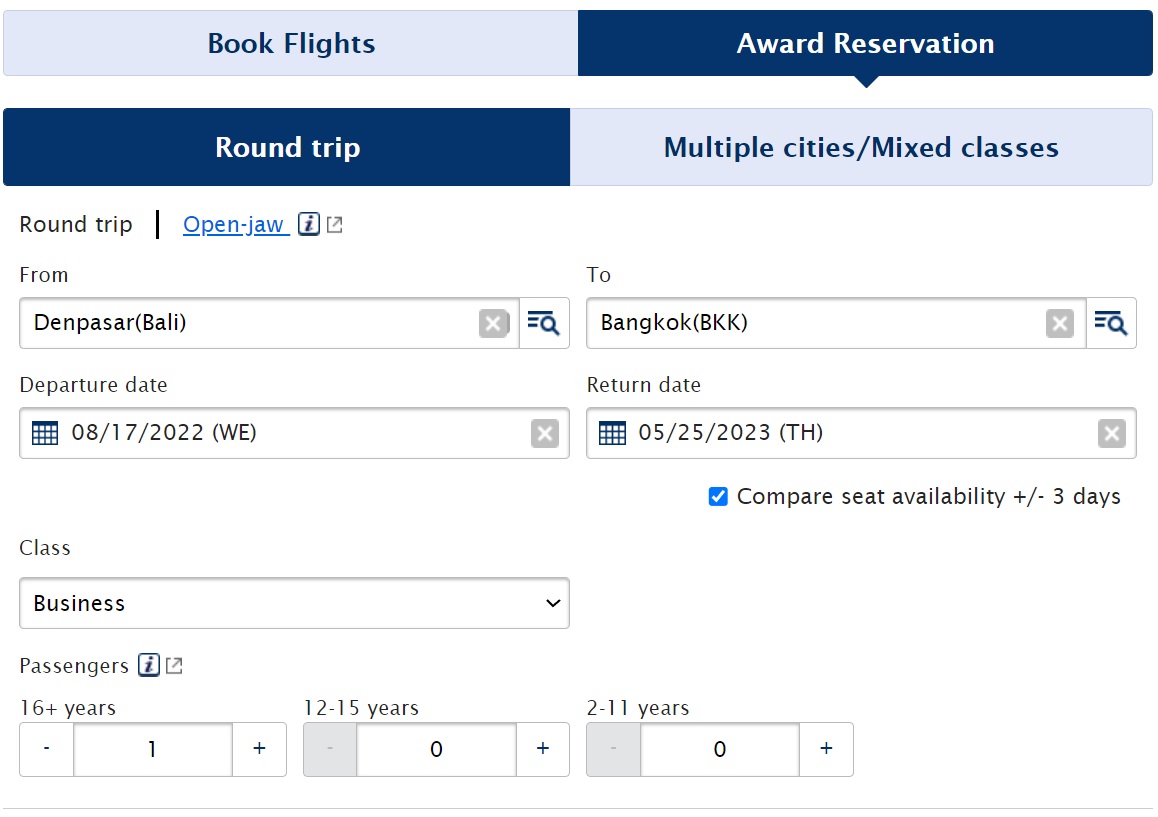
- Find the search tool: On ANA’s home page, click “ANA International and Partner Airline Flight Awards,” and then “Flight Award Reservations.” The system will prompt you to log in if you haven’t already. If you don’t have an ANA Mileage Club account create one (bonus tip when creating your account: It will ask you to create an AMC password. This can be any 4 digit number, but you need to remember it. It is used to verify yourself when you call ANA).
- You can’t search for individual one-way awards. Instead, use either the round-trip search or the “multiple cities / mixed class” search. Below are tips for when to use each…
- Round trip
- Allows searching 7 days at a time (make sure to check the box titled “Compare seat availability +/- 3 days.”
- Only searches the selected class of service (e.g. economy, business class, etc.). If there is availability in other classes, the system won’t tell you that.
- Can be used to estimate award taxes / fees for each segment. Do a round trip search with your segment of interest as the outbound, and try to find availability for both directions and on the same carrier. When you select the flights, ANA will show the total taxes and fees for the round-trip. Divide the result by two to get a very rough estimate of the cost of the segment that you’re interested in.
- Multiple cities / mixed class
- Shows results for all classes of service at once. This is very helpful since you may want to book some segments of your trip into economy if there’s more availability that way.
- Does not let you search 7 days at a time. If there’s no availability for the first segment on the date you entered you won’t get any results.
- Requires at least two segments.
- Won’t show taxes and fees unless you build a round-trip. Unless you design the segments to be a round-trip, you can’t get the system to price the award. Instead it will say “This service is not available for the specified itinerary. Please amend the flight criteria and try again.”



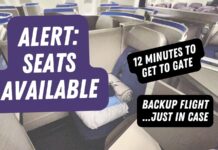

Two questions on surface segments:
Ahh…. the surface segments treatment for layover count is a bummer.
Thanks for the info.
You mentioned potentially being able to start in (e.g. Montreal) and end up in a destination US city. On the website it seems to indicate that the final segment has to touch the same country as the departure flight. Does anyone know if it’s possible to start and end just in “North America” (e.g. Start in Mexico, end in the US)
I haven’t tried that, but I do assume they will enforce the “country” rule. For example, I know that starting in Guam and ending in Hawaii works. I suspect they will not bend the rule to allow one to start from Canada and end in the US (though, if you try it and it works, please let us know).
I am in the planning stages for a Winter/spring 2025 trip. I have been running practice searches and have bounced flights from United to Air Canada to ANA to make sure I understand availability. The one quote from your article that is throwing me is:
I thought that United’s own flights were bookable via ANA for the RTW and my practice searches are showing they are. Can you explain this item from your article further? Thank you
Yes, United’s saver awards are bookable through ANA. In that sentence my point was that United.com will show many of their own flights that are not available as saver awards and those are NOT bookable through ANA
Gotcha. Yes. I was only considering the United flights that had an “I” indication that they are saver awards. Thank you for clearing up my confusion.
Thanks so much for the fantastic information. I’m planning a RTW trip and want to book business class with ANA for as many legs as possible, but my trip wouldn’t start until April 2024 and end ~February 2025.
Since flight schedules haven’t opened up yet for late 2024/early 2025. Would you suggest I book my last few segments for the latest dates I can find right now, then change the date/time later? Or just wait until early 2024 for the rest of the dates I’ll need to open up?
Good think-outside-the-box question. If there are only one or two easy-to-come-by segments at the end of the trip that are holding you up, it might make sense to book now and change it later. But if there are several important segments that are too far out now, then you run substantial risks by booking too early; I would recommend waiting until the calendar opens up. Either way, keep in mind that (in my experience) someone with no ANA status will have to wait over an hour on hold to speak to an agent for each call. So, look at the yearly patterns for the segments you have an eye on, and consider these questions:
1) How many segments are currently bookable now versus the ones that are not yet bookable? Is it 90%-10% or more like 50%-50%?
2) How certain are you that the not-yet-available segments will eventually open up in some form that you can live with? (If they open up in economy only, or in business but on less-than-ideal dates, will you be able to live with that?)
3) How willing are you to rebook each time that segments you need open up? (Are you prepared for 1+ hour hold times to redo the itinerary *each* time a segment opens up?)
Another caveat to beware of: ANA likely will force you to keep the segments in chronological order. That could be a challenge if you have multiple segments that you need to reschedule. For example, lets say you plan on 6 segments total, with three bookable now, and three that are currently beyond the award schedule. So, you book the 3 desired segments as you want, and the next three as placeholders. Then, closer to your trip, you see that segments 4 and 5 have opened up availability on dates you want, but segment 6 has absolutely no options to reschedule to when you need it. You’re stuck. You can’t move segments 4 and 5 to a date *later* than your placeholder for segment 6. You would need to move 6 out to some date further out so that it is later than 4 and 5, but if that’s not possible, you’re up the creek…
Of course, I understand the anxiety of waiting to book until later–what if the business class segments that are bookable now dry up? If that happens, you might consider booking them in economy for now and set up an award alert (such as with ExpertFlyer) if the business class seats open up again later.
Will’s advice is very good. One additional thing to think about is this: if you book now, you’ll be locked into the exact routings even if something better comes up. For example, suppose your final leg is something like Sydney to SFO. If you book now, maybe you pick SYD-TYO-SFO on ANA, but later maybe United nonstop SYD-SFO will open up. ANA won’t let you change to that flight.
Thank you both for the great advice – I’ll wait until the entire trip opens up on the schedule. Cheers!
Can you book ANA RTW with Virgin Miles ? And how.
No you cannot
Thanks Greg for the great blog! What happens if a leg is cancelled by one of the partner airlines? I asked an ANA agent but her answer doesn’t seem like it could be correct?
For example, I’m flying ORD-IST-SIN-DPS-TPE-ICN-LAX on an ANA RTW award.
What happens if I’m in Istanbul already and Singapore Airlines cancels my IST-SIN leg? She said that award space has to be available on the next flight out? But I’d assume if Singapore Airlines cancelled the flight they would have to get me on the next flight even if ANA Award inventory wasn’t showing up?
Do you have any experience on this? It doesn’t seem possible that they would just leave a passenger stranded halfway on their trip around the world through no fault of the passenger.
I asked her in this scenario what would happen and worst case scenario, would I be able to purchase on my own a ticket from IST to SIN and she said if I missed that flight then the rest of the ticket would be cancelled.
Is this correct??
I don’t know what would happen unfortunately. My guess is that it would be fine. It’s hard to imagine that they would mark you as a no-show.
[…] consider here as suggested by ThePointsGuy, but I would just keep it simple with these criteria by FrequentMiler, recreated below. Green = little/no fees, orange = moderate fees, red = high […]
Do they have to be specific awards to book via ANA. Like I know for Turkish to book United it needs to be saver award. If I’m looking through air Canada and find a partner award flight PDX to Seoul do I need to find any specific price to be able to book through ANA or should any flight work?
I have the same question. I saw a post on another blog saying it had to be “I” space for business but i thought maybe that just meant for United flights? It would be very annoying to think Ive found space then have ANA say it’s not available because it’s not “I”
Don’t worry about the booking codes. The trick is to see if each flight is bookable via another Star Alliance program. For example, for most segments, you can check United.com to see if it’s possible to use United miles to book the segment. If you’re looking at a United flown flight, though, you’ll want to use aircanada.com to see if a points-award is bookable on that United flight.
Yes, they need to be saver awards exactly like using Turkish miles to book United.
In your article (which is very helpful!), you wrote: United will show award space for its partners that are not Star Alliance carriers (Hawaiian Airlines, for example).
What about a Hawaiian Airlines flight that is a codeshare United flight? Will ANA reject that?
Hawaiian Airlines is not a Star Alliance airline, so you cannot book them as part of a RTW award
[…] The last step was to pay for taxes, fees, and fuel surcharges. Some Star Alliance partners pass on fuel surcharges to award redemptions, so we tried to minimize flights on those partners as much as possible. However, it wasn’t completely possible to avoid, so we paid a total of $875 per person for taxes and fees. Not bad for 10+ flights in business class, IMO! A list of partners by their fuel surcharges is discussed on Frequent Miler. […]
Thank you writing up the tips! The tips for searching on ANA have been really helpful as I’m currently building a RTW trip to book through ANA. Is it normal to see “I” award space on Lufthansa in the United search result but not in ANA’s? Is United seeing phantom availability or does ANA not see the same availability for Lufthansa that United does?
ANA should have the same availability as United for Lufthansa flights so yes maybe you saw phantom availability. I don’t know.
I would be starting out in Nashville and would like to fly to paris, there is a short layover in toronto for the flight I would like to take. Would that distance be calculated into the total mileage flown for the award chart?
Yes, all flight segments are included in the total mileage flown
Hi Greg. Fantastic and comprehensive source on the topic and far ahead of the other articles I read to get smart on this hidden gem. 2 questions:
1) Do you think the following itinerary qualifies? I believe it does but wanted to see if it violated any rules? IAD-IST-ISB-BKK-DPS-TPE-JFK
2) I am planning on going with my wife and soon to be born infant. Any idea whats the additional cost of the infant? infant will be <6m old at the time of the flights. Also does the baggage policy of each airline apply to each leg if we think about baggage and stroller etc or is there a consolidated single baggage allowance for *A Biz?
1) Yes, that should work
2) No sorry I don’t know about the lap infant cost or whether the baggage rules vary.
Booked our RTW trip this week (for July/Aug 2023), process wasn’t too difficult other than finding availability in some cases. On a couple of legs (LAX-NRT on ANA for instance), there wasn’t any business class available right now. What’s the best process for checking back to see if any opens up?
I like using an Expert Flyer subscription for that, since you can set an award alert for the flight in business class. If you have the flexibility, I would even set alerts on alternate flights before/after yours in case one of those flights opens biz class. So long as an alternate flight is on the same airline and route as originally booked, you’ll be able to change to that flight for free.
Not sure if this has already been mentioned, but having ANA Platinum status can provide additional business inventory on ANA flights. When searching availability on the website, even though there was no “I” business class availability from NRT – HNL, the ANA website showed 1 business class seat available as part of an “ANA Award” rather than “Star Alliance Award” (the latter I believe only shows “I” inventory). I called in and was able to book the Business seat for me but not P2 as part of a RTW segment date change; the agent said the additional availability was because of my Platinum status. This was also interesting because it allowed me to get this seat availability (May) after my Platinum status expires (March). So perhaps if you book a RTW trip before your Platinum status expires, you may be able to book this expanded availability.
It hasn’t been mentioned before, but it did come up in my bookings as well. I’ve now added it to the post. Thanks!